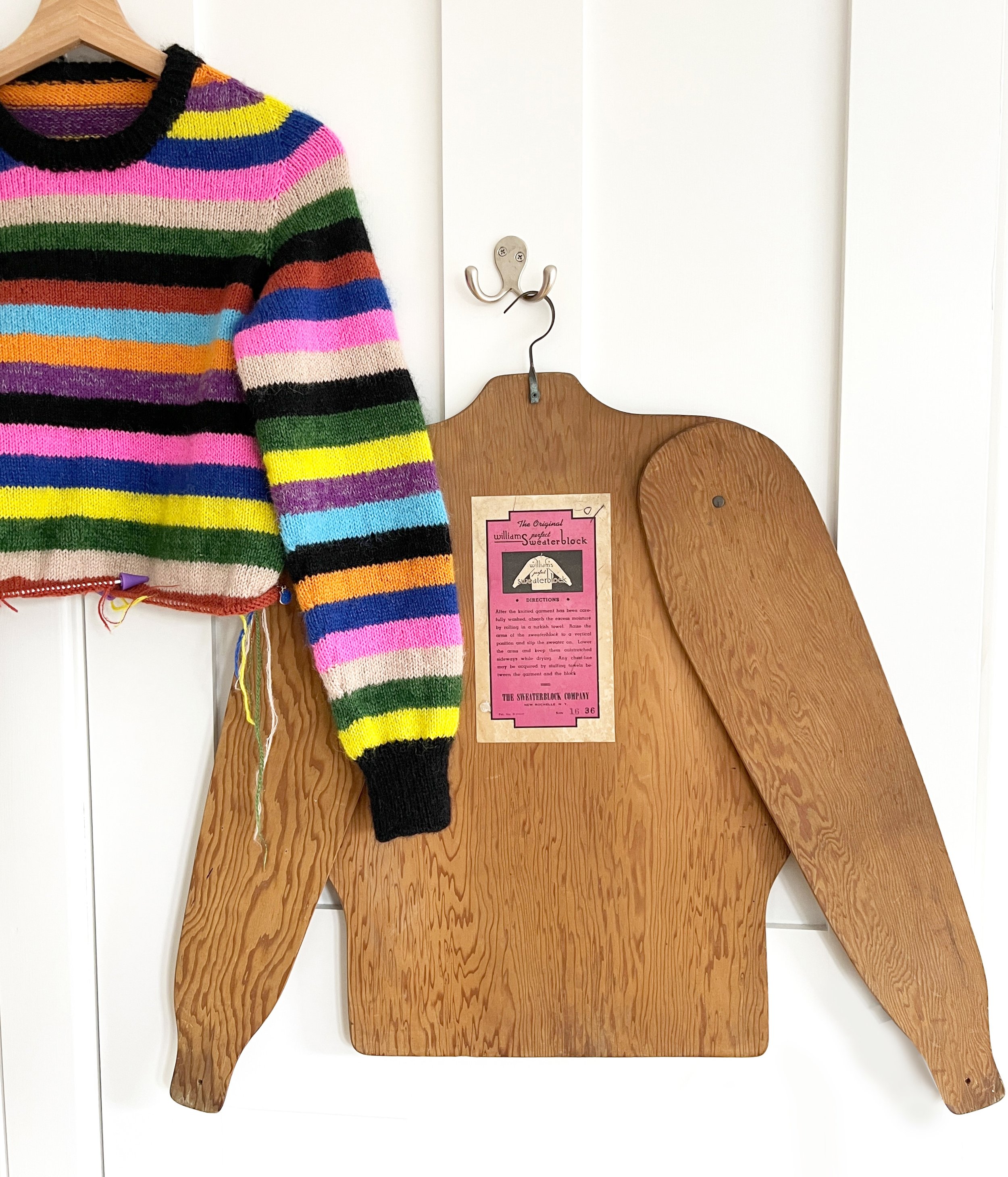ANTIQUE SWEATER BLOCKER - THE ORIGINAL WILLIAMS PERFECT SWEATER BLOCK
My antique Original Williams Sweater Block with a sweater I’m currently knitting using Petit Knit’s Aros Sweater pattern.
Due to my slightly nomadic lifestyle, I don’t buy a ton of decor items or anything heavy or bulky. When it comes to vintage, I limit myself to small, useful items: sewing patterns (of course!), notions, maybe a tool like a nice ruler. Well, this item is not small, but it won’t take up a ton of space, either. And it’s useful. And beautiful! I present to you, my brand new antique sweater blocker!
This Original Williams Sweater Block is in amazing condition, with both the original label and the hanger in tact. It is functional, but will double as wall art!
I might not buy much, but I love to browse. Jason and I were passing through Germantown, NY yesterday, and realized that we had never stopped on the town’s small main street. We parked the car and checked out every shop that was open (very cute!). We poked in to Luddite Antiques, where I spotted this curiosity leaning against a wall with some artwork. It was love at first sight!
Original label with instructions for use of the Original Williams Sweater Block. This one is size 16 / 36” bust.
I’ve seen sock blockers and the various molds for blocking gloves and mittens, but I didn’t know there were blocking forms for whole sweaters. Luckily, this one had the original label in tact. It was manufactured by The Sweaterblock Company in New Rochelle, New York (about 1.5 hours drive south of where I bought it), Patent Number D110587, and as for instructions, it reads:
“DIRECTIONS: After the knitted garment has been carefully washed, absorb the excess moisture by rolling in a Turkish towel. Raise the arms of the sweater block to a vertical position and slip the sweater on. Lower the arms and keep them outstretched sideways while drying. Any chest-line may be acquired by stuffing towels between the garment and the block.
How charming?! Love the idea of stuffing your sweater to accommodate a larger bust.
The hanging hook and label are intact! I had to clean off a little bird poop and some cobwebs. Otherwise it is in excellent condition!
This sweater block is labelled: “size 16 36”, which I take to mean it is for a 36” bust. I measured the widest point on the chest to be 16.75” across, if we double that, it gives a finished circumference of 33.5”. I am assuming this allows for 3” of negative ease - a sweater with a finished, blocked measurement of 33.5” could stretch over a 36” bust. And don’t forget, you can pad the block with towels to achieve a larger measurement.
A bit of googling has lead me to understand these sweater blocks were manufactured about 100 years ago, at some point between 1900 and 1930. I’ll need to dig a bit more for further information. I sew a lot of 1970s sewing patterns, where size 12 is a 34” bust; 14 is 36” bust; 16 is 38” bust. It is my understanding that commercial pattern blocks changed - modernized - a bit in the 70s, so patterns prior to that would be smaller. That is true to my experience with 50s and 60s patterns. I don’t have any sewing patterns as old as this sweater block, but I am presuming the “36” on the label is the bust measurement because I can deduce that size 16 would have a 36” bust, and that would be somewhat in line with other tools and products designed for making your own garments at home.
Antique wooden sweater block with a contemporary sweater layered over the top - how fun to see the timeless potential of this tool!
For what it’s worth, I am currently knitting the Petit Knit Aros Sweater in size Medium, and . At this size, the sweater is intended to have a 39” bust after blocking. This is my second time knitting the sweater, and I think my gauge is likely closer to size Small (finished bust 37.5”), but it could easily be blocked to 39”. I guess what I’m saying is, sizes don’t matter - they’re totally made up and inconsistent! Many factors have changed over time. But this block is luckily in a size range that I can actually use!
I love how the sweater block has a tapered area for cuffs! The holes are so you can position the arms in the correct position while your sweater dries. The arms are on hinges and will otherwise be pulled down by gravity.
Most of the sweater blocks I’ve seen online are very similar to this one, in varying conditions and prices. I paid $68 for this without any knowledge of the item or its history, and feel it was fairly priced.
I need to frog (rip back ) two stripes on this sweater body, then re-knit just one, and then add my black ribbing. I have been unmotivated until this block entered my life. I may chose to pad it with towels, but I intend to use the block when this sweater is complete and ready for that step. So stay tuned, I’ll definitely document that process.
Let me know if you know anything about these wonderful sweater blocks! XO, Martha
Feeling joyful right after my purchase!






